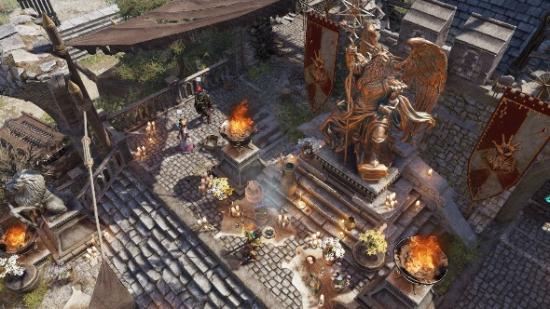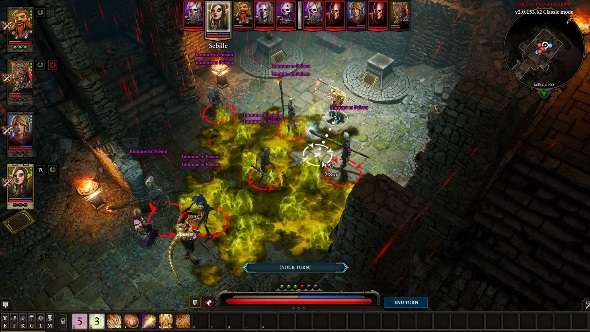When you’ve made one of the most critically revered RPGs in recent memory, what do you do to follow it up? Bigger and better may seem the obvious answer, but when you take into consideration how expansive Divinity: Original Sin was, it’s no small challenge trying to exceed those levels of ambition. But that’s exactly what small Belgian indie Larian Studios have done with Original Sin 2.
So you’re into role-playing, eh? Strap on your helmet of +5 knowledge and learn about the greatest RPGs on PC.
Recently I visited the studio to spend six hours playing the game across all its different modes – single-player, co-op, and PvP multiplayer – and get a real taste of the game. Upon my return I asked you guys what you’d like to know about. I’ll answer specifics in detail in just a moment, but let’s start with all the new details I brought back from Belgium.
- You can create a character with distinct personality ‘tags’ that affect how NPCs see you
- Or you can use a character with a pre-made ‘origin story’, each of whom have their own agenda
- Characters in your party have their own goals, which can can conflict with the aims of other heroes and lead to arguments, fights, and even death
- The game’s starting zone is Fort Joy, an island fortress with a huge collection of things to discover
- Your abilities are governed by ‘memory’, a new stat that dictates how many skills you can have equipped
- There’s a new armour system, which works like a second health bar to absorb either physical or magic damage
- Element mixing is back, and the combinations are more inventive than ever
- PvP arena mode is a battle between teams of high-level characters equipped with devastating skills, but you’ll need to collect a special resource to use them
What’s character creation like? Is it Roderick and Scarlett again?
Not quite. For one, you’ll only be creating a single character, although they do default to Roderick or Scarlett depending on your gender. But there’s so much more to creating a hero this time. You can choose a race – human, dwarf, elf, or lizard – and a class from a huge selection including battlemages, witches, shadowblades, and clerics. You can even pick an instrument that will play a little melody when your character achieves something. The points and talents-based RPG system makes a return in a familiar but improved guise, and you have a strong level of control over this when building your character.
The biggest addition though is tags, which are really what make your character unique.
I’ve heard of these tags before. They’re to do with dialogue, right?
Yeah, they dictate how you interact with the world. ‘Nature’ tags, based on your gender and race, dictate how NPCs react to you (for example, lizards don’t much enjoy the company of elves), while ‘aspiration’ tags take this to a more personal level. When creating your character you can pick two aspiration tags, such as ‘scholar’ and ‘villain’, and these unlock relevant options during conversation. If you take the ‘jester’ tag, for instance, you’ll be able to select unique dialogue that’s based around practical jokes or being a bit daft. There are ten tags, and they really help you build a character that’s unique to the personality you want to role-play.
There are also special tags that are only available for pre-built characters, too.
Pre-built characters? What do you mean? Like Geralt in The Witcher?
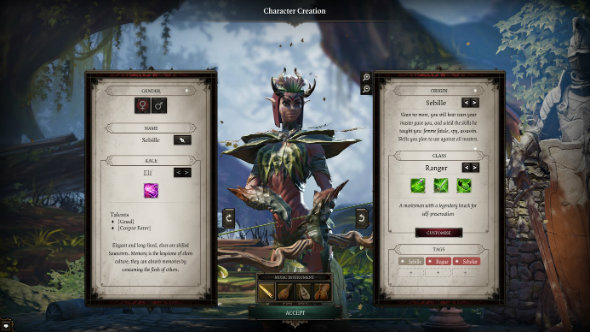
Almost. While you are free to create any character you want in Original Sin 2, you can select from a set of pre-built heroes, too. During our hands-on there were four to choose from, and Larian promise there will be more to come, too.
Pre-built characters are really interesting. You still have a great deal of choice – their appearance and class are entirely up to you – but they have pre-defined personalities for you to role-play. Each has a special tag which provides them with unique dialogue options, and these help build the character’s personal quirks through some really great writing.
The biggest element they add, though, are origin stories.
Origin stories? Like getting bitten by a radioactive spider?
Kinda, but with less spandex. Each hero has a history that affects them during the game. This comes in the form of a unique mission path to follow in addition to the main and side quests within the world.
Let’s take Sebille as an example. She’s an elf who has escaped from slavery, and is now looking for violent vengeance. On her arm is a tattooed list of targets, and throughout the game you’ll be hunting these people down. With each kill you can cross off a name using your ink needle. Basically, she’s Arya Stark.
Each character is radically different thanks to their origin. Sebille, despite her hard life, is also a bit of a prankster (when playing as her, the first thing I had her do was try and push a character off a dock into the sea). This is a huge contrast to The Red Prince, a crimson-skinned lizard who has been exiled from a life of nobility. He’s pretty pissed about this, naturally. But that’s small-fry compared to Lohse, a human who’s struggling with the fact that she’s possessed by a demon. When playing as her, occasionally the demon will take over and replace all your dialogue options with delightful things like “Kill them! Kill them! Kill them!” It can lead to some very tense, sometimes bloody situations.
These origins make pre-built heroes significantly more interesting than the create-you-own ‘generic’ characters. As a generic you miss out on both unique personality-based dialogue and special origin quests. However, you don’t have to go without on these characters entirely. The pre-built heroes you don’t choose are placed into the game as NPCs, and they can be recruited into your party should you find them. As with the last game, you have complete control over all party members, so you’ll be able to play with every hero even if you don’t choose them as your main.
What happens when characters with conflicting goals get into arguments? Is that rock, paper, scissors thing back?
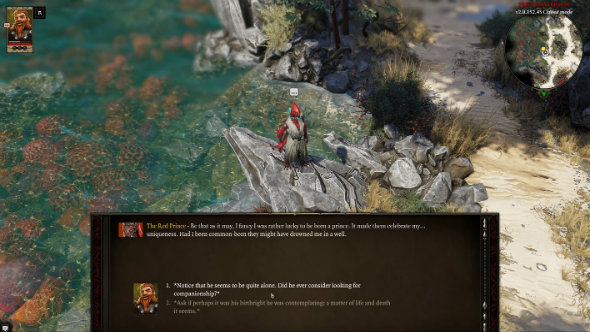
Naturally with a cast of characters so diverse, there are going to be disagreements. Original Sin 2 is designed for up to four players though, so rock, paper, scissors wouldn’t make much sense. Instead, dialogue options are used far more extensively, as we discussed with studio head Swen Vinckie earlier this year. Or, if chatting fails, swords work too.
See, sometimes talking it out just won’t be enough. Some characters have goals that clash like titans. For example, one of Sebille’s first targets for her personal quest is also a contact that The Red Prince wishes to talk with. That’s a huge conflict of interest, and a very interesting scenario when played in co-op. Players have a shared journal, but the details of personal quests are kept private, so both players could be completely unaware of such a situation.
The result all depends on how players interact. If you discuss everything, you may calmly decide between you who gets to fulfill their quest. But if played sneakily, Sebille could withhold that information. Perhaps she splits from the party for a few hours and kills her target before The Red Prince even thinks about finding them. Or, if the target has been discovered by the whole party, Sebille could incapacitate the Red Prince to make sure he can’t stop her. How about a ‘health potion’ which is actually a poison in disguise? Or a simple backstab? PvP combat is as valid a solution as dialogue or pranks, and helps generate interesting drama between co-op characters.
Wait, so my co-op partner can kill me? What happens then?
The systems you’re used to when playing solo apply to co-op, so killed players must be revived using a resurrection scroll. In two-player co-op each person has control of two characters, so if one of your heroes has died you can have the other perform the resurrection. If both are dead, or you only have control of a single character, it’s time to sweet-talk a co-op buddy into helping you out. That may sound a little punishing, but it’s certainly within the spirit of Original Sin.
Tell me about the new starting zone. Does it try to hold my hand too much?
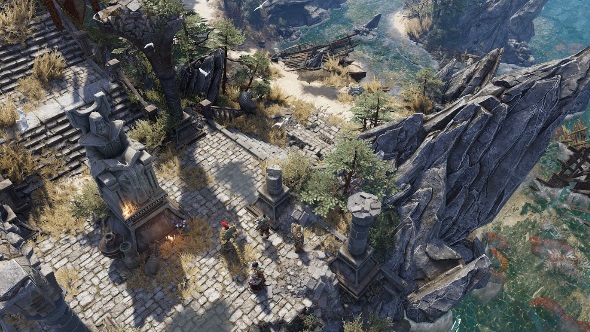
Not at all. What you remember about Original Sin remains in entirely applicable here too. There’s very little guidance for where you need to go, and progress relies on you talking to pretty much every NPC in hope of discovering even the smallest hint of where to go next.
The hands-on session took place at the very start of the game in Fort Joy. If you know about Divinity’s ironic sense of humour, it’ll come of no surprise that Fort Joy is an island-based concentration camp for magic users, with a tight grip on its inmates thanks to special, deadly collars. You begin the story washed up on its beach with nothing but a single goal: escape.
Of course, that’s not the only thing you can do at Fort Joy. Researching how to make your exodus will often lead you astray, uncovering the multiple side quests that the Fort harbours. This sizeable area is home to dozens of NPCs – both prisoners and guards – many of whom have deep conversations to offer and favours to request.
Even the simple act of walking around reveals how absurdly deep this starting zone is. One of my characters fell down a hole and got stuck in a dungeon, which prompted me to lead my other three heroes on a rescue mission. To complicate matters, the dungeon that I had fallen into was occupied by guards who were covering up a murder, and they weren’t too fond of this new witness. A simple slip-up led to scouring the world for a hidden dungeon entrance and stopping a guard conspiracy. It’s just one example of how Divinity treats all player actions with an equal sense of importance and depth.
There’s a more foreboding tone to this world than the previous game, with brutal guards, sinister creatures, and a general sense of misery abundant in the camp. But the Terry Pratchett-esque madness is still there: one of the earliest characters encountered is a crab convinced he’s a wizard. Yup, talking to animals is definitely back.
In many ways Fort Joy is an overwhelming environment to start in. Without even a NPC to act as a guide, you need to work out who are friends and foes, attempt to recruit a party, and discover how to get out. Larian promise there are multiple methods of escape, some more obvious than others.
What’s new in the combat? And what the blazes are memories?
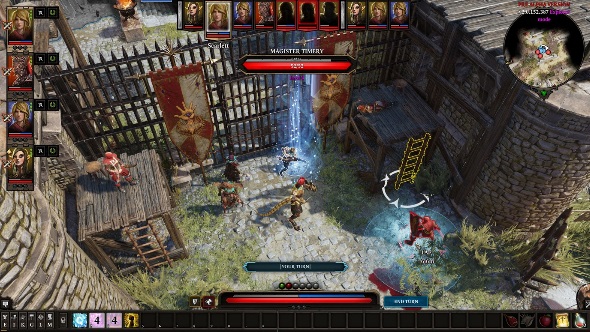
Once again Original Sin opts for a classically difficult turn-based system, and while it feels very familiar, there are a few changes to the RPG system since the first game that affect how combat works.
The first of these are memories. Your character can only ‘remember’ so many spells or skills at a time, dictated by a stat that can be improved as you level up. The more points you put into it, the more memory slots you can use. When you have free slots, it’s simply a case of choosing skills from your library, and these will be the ones you use in battle.
In effect this is a system that forces you to consider which of your many skills you may need for coming battles. It also adjusts your approach to levelling a character: do you put more points into memory to allow a wider pool of spells and skills in battle, or make do with less memory and put more points into, say, strength, so those fewer skills are more powerful?
The other notable change in combat is armour. Characters can have both physical and magic armour, represented by a bar that appears above their health points. Armour generally takes damage before health, and so works as a buffer layer. Devastating physical attacks that would insta-kill unarmoured targets can be brushed off by physical armour, while magic armour can protect against particularly tricksy spells. Of course, there are skills that can help you bypass armour, so it’s all in the tactical approach.
So how about those elemental systems? Anything new?
Like you wouldn’t believe. Original Sin 1 already felt light years ahead of other RPGs with how it dealt with using the environment and combining elements to amazing/disastrous effect, but Original Sin 2 adds another huge array of possibilities.
A personal favourite comes in the form of magic flames. Let’s say an enemy has spilled a barrel of oil around some of your party members and set fire to it, leaving your heroes to stand in a damaging inferno. Rather than trying to beat a hasty retreat from the flames, you could have a wizard character bless the fire. The roaring heat now turns a cool blue, and gradually heals anyone stood in it.
Your enemies can exploit this though. The flames don’t discriminate, so foes could simply march into the glow and top up their HP. Or, if they have access to the right magic, they could inflict a status on your heroes that turns healing into damage.
If we spin the whole situation on its head and imagine enemies stuck in a puddle of flaming oil, we can ensure their demise by cursing the fire. This makes the burning difficult to stop, trapping them in a cycle of continual damage.
That’s four different examples relating to just one scenario. Pretty much every environmental hazard and magic spell has a new and exciting interaction, and much of the fun in Divinity’s combat comes from exploiting them for maximum effect.
How about the rest of the world? Is there a big change in interactivity?
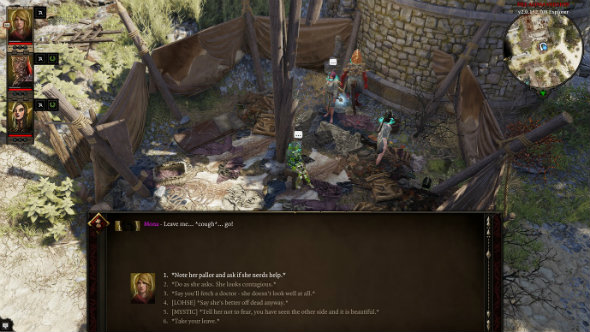
Not exactly. Original Sin 2 doesn’t feel hugely different to its predecessor in its approach to freeform simulations, but it’s certainly an expanded version of that effort. Think back to your favourite classic isometric RPGs and imagine what they’d be like today if they’d had ten sequels. That’s very much the feeling you get when playing Original Sin 2.
Much of your approach to the world is given depth through conversation, more so than systems, and tags means that conversation can be wildly different depending on which party member initiates the dialogue. Not only do tags dictate how people treat you, but offer up new methods of directly interacting with people. This can be simple (for example, being a bit aggressive if you have the ‘soldier’ tag), or open up specialist branches of conversation that could lead to interesting information. Our hands-on didn’t show us the full extent of where this could go, but it looks promising.
The other thing Divinity does is force you to re-think how you navigate its world. There are plenty of environmental obstacles that you’ll need to overcome using similar logic to that seen in combat. For example, puddles of acid need not be an impassable barrier. A warrior can perform a heavy slam attack that pushes back enemies, or in this case splits the acid puddle like the Red Sea.
I heard it’s got PvP multiplayer. It’s going to be awful, right?
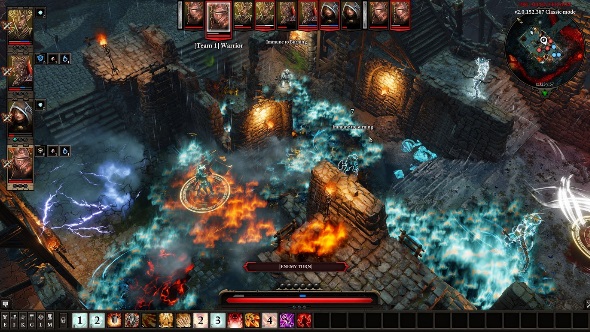
I get why you’d think that. What predominantly single-player game ever had a good multiplayer, especially when it comes to RPGs? Thankfully I can assure you that Divinity: Original Sin 2 bucks that trend. How popular it’ll be remains to be seen, but the PvP is genuinely terrific.
To be clear, when I say PvP multiplayer I mean proper arena-based combat. When playing the campaign in co-op you can go toe-to-toe with your buddies, but Original Sin 2 has an arena mode that’s purely about tactical combat. Think of it as a little like XCOM’s multiplayer, then splice it with Magika.
I make the Magika reference because Arena is genuinely a hoot. I played it with a guy from Larian (over LAN, if you’re interested in networks) and we had great fun causing all sorts of accidental destruction with powerful magic spells. People died, the wrong heroes were attacked, and spells seriously backfired.
The basic set-up is this: a symmetrical arena battleground for two players, who each have four heroes. These are pre-built and selected from the match’s set-up screen, and are already high level with a huge range of skills at their disposal. Both my adversary and I used identical teams of a human warrior, an elf ranger, a lizard wizard, and a dwarf rogue.
Arenas are home to a variety of obstacles, be they simply raised platforms or blazing infernos. There are also a couple of shimmering pools known as Source Points: walking a character into these provides a special resource, used to fuel their most powerful ability. As you can imagine, dashing to get these points is a big focus of the game.
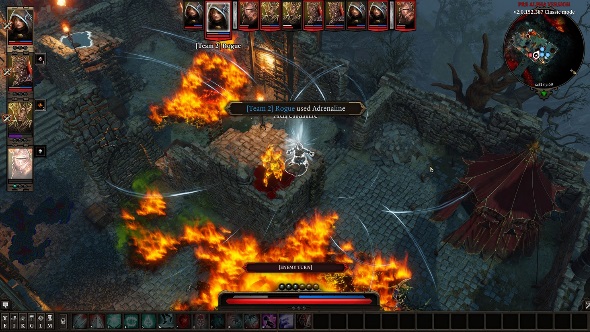
Should you fail to grab a Source Point, there are other methods of obtaining them. For example, certain characters have a vampiric ability that can steal Source Points from other characters, or even leech them from corpses. It’s great fun to see your enemy convinced they’re in position to make a major strike, only to deny them the resources they need.
A simple match is filled to bursting with this kind of intricate madness. During a match against Larian my rogue was almost decimated by the enemy warrior, which came as a surprise considering my opponent had made several blunders (including turning offensive fire into healing flames, much to my benefit and amusement). Dealing a killing blow to that pesky warrior, I proceeded to use my last action point to walk my rogue into those aforementioned healing flames.
This unexpectedly caused my rogue to collapse, a tombstone rising to denote his place six feet below.
The guy from Larian burst out laughing. I’d failed to realise he’d pre-planned all this, and made sure my rogue was inflicted with the curse that turns healing into damage. I’d failed to read my status indicators, and fallen into his trap. What a big sneak.
Arenas are also relatively tight, so the huge storms you can create when mixing elements can turn entire corners of the map into inhospitable hellholes. There’s always a way out though. Have a hero stuck in an acid swamp? Just use a magic spell to swap places with an enemy. They won’t be laughing anymore.
So what you’re saying is: Divinity: Original Sin 2 is pretty good, yeah?
Yup. It’s a huge sequel to a great game, and feels more ambitious and inventive than any other RPG out there right now. After having played a good few hours of it, it’s hard not to be as excited as a kid at Christmas about it. Thankfully you won’t have until Christmas though, as Divinity: Original Sin 2 goes into early access September 15.
